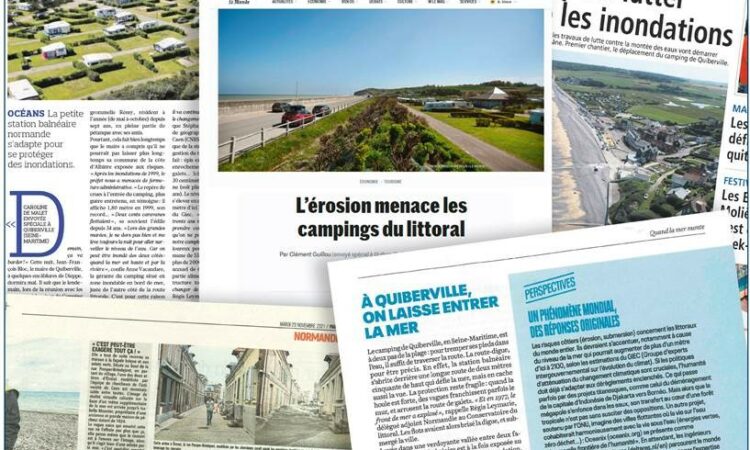
The Basse Saâne 2050 project has put Quiberville, Longueil and Sainte-Marguerite on the front pages of the national and regional media. From now on, the lower Saâne valley is a model of adaptation to climate change.
“The sea is going to heckle us” is the title of the report on the Saâne in L’Obs on 30 October 2021. “To fight against the consequences of climate change, a territorial project of “land-sea reconnection” is planned,” continues the weekly. Its aim: to give back its original place to the coastal river and let the sea into the valley”.
A few weeks earlier, the daily La Croix had published a report entitled “Rising waters: how French coastal towns are adapting” with a focus on the Saâne and its project.
Since then, it has not stopped: in 2022, most of the major national media devoted reports to the lower valley, interviewing the elected representatives, those involved in the project, and the users of the current Quiberville campsite… Unquestionably, the relocation of the campsite, the re-connection of the river to the sea, and the sanitation efforts made by the Longueil wastewater treatment plant impressed the journalists, including print and television media.
On TV, TF1 and France 2 made the trip, and the Saâne was honoured on the “20-hours” of France 2 and the “13-hours” of the channel 1. On the public service, France 24, the international French-speaking channel, is not to be outdone: in October 2021, it was through two reports in the Saâne that the channel illustrated the challenges of climate change on the occasion of COP 26, which took place in Glasgow. The journalist Cyrielle Cabot used the case of the Saâne to highlight the coastal risks on the one hand, but also the solutions for adapting the territory to the new conditions and the expectations of the inhabitants and users.
TF1, for its part, relayed the hopes and fears of the regulars of the current campsite, which they will have to mourn. Its report (“Erosion: the last days of a campsite”) focused on the choice facing these holidaymakers: migrate to the new tourist facility or give up the holidays on this stretch of Normandy coast to which they have become accustomed, sometimes for several decades. “Relocating an economic activity because of the climate crisis: this project is one of the most advanced in France,” France 2 explains in its report broadcast on 5 July 2022. And the public service channel warns that the 7 million euro cost of relocating the campsite will have to be multiplied in the years to come: “the retreat of the coastline affects the whole of France, companies will have to move, as will individuals”. This project,” continues France 2 journalist Sandrine Feydel, “has taken nearly 10 years to complete. It is one of the rare examples of adaptation, too rare according to the High Council for the Climate. For him, France is not ready to deal with future climate change.
The same conclusion was reached by her colleague Caroline de Malet in Le Figaro on 7 November 2022: “Beyond the region, Saint-Jean-de-Luz and Lacanau, to name but a few, are also planning fallback solutions. But a comparable project is more difficult to implement in a region where land is even more scarce and expensive. His report is entitled “How Quiberville will relocate its campsite in the face of rising seas”. Financed 70% by Europe and 30% by local authorities,” explains Le Figaro, “this project is part of a wider approach. But without European funding, it would not have been possible. At the same time, a wastewater treatment plant will be built in Longueil, inland, so that the wastewater will no longer affect the quality of Quiberville’s bathing water. Finally, the 1.5-metre-diameter culvert through which the Saâne flows into the Channel – blocking the passage of migratory fish – will be replaced by a ten-metre-wide bridge over the coastal road to connect the land to the sea.
Quiberville is a model, and a rare exception,” writes the daily Le Monde, in a report on the evolution of coastal campsites throughout France. The relocation of the campsite foreshadows a not-so-distant future, according to climate change specialists. The increase in violent events could require the relocation of sites set up in the 1970s, when the coastal law and the protection of natural areas did not exist. In addition to climate change, there is the State’s new doctrine on the risks of marine submersion: no more protection, which is considered costly and ineffective in the medium term, but rather adaptation. And like his colleagues on France 2 or in Le Figaro, Le Monde journalist Clément Guillou notes the pioneering nature of the Basse Saâne 2050 project: “The Ministry of Tourism estimates that 369 campsites are threatened by the retreat of the coastline. Nearly twice as many are on the 100-metre strip of coastline, and a quarter of the 7,800 French campsites are exposed to a natural risk – marine submersion, coastal erosion, flooding or even rock falls. These campsites are the best placed and account for half of the total number of visitors, according to the National Federation of Open Air Hotels.
After the journalists, it would not be surprising if the outdoor tourism professionals came to the valley to find solutions to their existential anguish…




